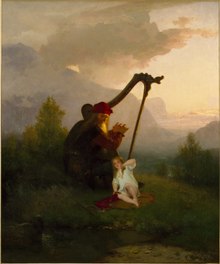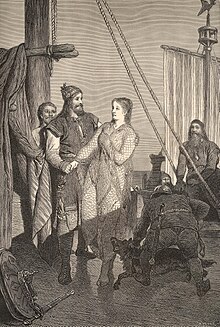Aslaug

Aslaug Sigurdsdóttir , (Swedish Aslög ), nickname Kráka , Randalín , was a legendary Danish queen (Dronning) from the 9th century. It is described in detail in the saga of Ragnar Lodbrok and mentioned in the Ragnarssona þáttr and the Snorra Edda .
Aslaug's youth

Aslaug is the daughter of Sigurd Fafnesbani (Siegfried the Dragon Slayer) and the Valkyrie Brynhild . After her violent death, Brünhild's foster father Heimir takes care of Aslaug. Concerned for her safety, he has a large harp made in which to hide the girl. The harp is also filled with precious clothes and gold. When the child cries, he plays for Aslaug to calm her down because he is a great harp player. When he arrives at a huge river, he washes the girl and hands her food. Disguised as a poor harp player, he travels through Norway until one day he comes to Åke and Grima's farm in Spangereid in Lindesnes and asks for accommodation there. First of all, he is hospitable and entertained. He leaves the harp close by, but Grima sees a scrap of precious material sticking out of the harp and a gold ring shimmering under Heimir's torn clothes. Grima encourages her husband Åke to kill the strange guest in order to get the supposed wealth. Åke hesitates at first, but when Grima suggests that the stranger has approached her, he kills Heimir in his sleep with an ax. When they then break open the harp by force, they discover Aslaug, who is more beautiful than they have ever seen a girl. They give it the name Kráka (crow) after the mother Grimas. They raise Aslaug like their own daughter. But since they are both ugly and do not want to arouse suspicion, they force the girl to blacken her face with soot and henceforth to wear black clothes to hide her noble ancestry. Kráka has to work hard for her and lives in poor conditions similar to Cinderella until she becomes queen by marrying Ragnar Lodbrok.
Aslaug's nickname Kráka
Aslaug's nickname Kráka refers on the one hand to her dark appearance (black, dirty clothes, blackened face), which is reminiscent of a crow. It can also refer to Aslaug's role as a stepmother (of Agnarr and Eirekr, the sons of her husband Ragnar). In Norwegian fairy tales, evil stepmothers are called Kråke (Kráka), while in Faroese fairy tales nasty stepsisters are called Krákudóttir . In any case, a bird name is obvious for someone who, like Aslaug - as an inheritance from her father - understands the language of birds.
Aslaug and King Ragnar
Aslaug meets Ragnar's men
After Ragnar's wife Thora dies , he sails to Norway and anchors in a small port off Spangereid in Lindesnes. He sends his people out to get food on land. They see a small courtyard with a garden and think that it is easier to carry out their task of baking bread there. They meet Grima in the yard and ask her to help them bake bread. Grima tells them that their hands are too stiff for this job, but that she has a daughter named Kráka who can help them with it. Aslaug had seen the ships in the harbor early that morning while shepherding sheep and, against Grima's request, washed himself, since no one should see how beautiful she was. When Kráka returns to the farm, the men are amazed at her beauty and wonder whether she is really the daughter of the ugly Grima. The doubting men agree with the beautiful Aslaug that she kneads the dough while they bake the bread. Although the girl does her part of the job, Ragnar's men cannot take their eyes off her and the bread burns in the oven.
Aslaug's exam
When the men return to the ship with the burnt bread, they tell King Ragnar about the beautiful Aslaug and that they have never seen a more beautiful woman in the world. However, Ragnar is certain that no woman could be more beautiful than his late Torah. He orders the girl to come on board. In order to test her cleverness, he decides that she must not come hungry or full, neither clothed nor naked, alone or accompanied by a henchman. Kráka obeys Ragnar's orders. She wraps herself in a fishnet over which her long hair falls. That way she is neither naked nor clothed. She bites into an onion that is not counted as food and shows that she is not starving either. At last she lets her dog follow and does not come to Ragnar's ship alone or in the company of a human. Overwhelmed by her cleverness and beauty, Ragnar affectionately asks the girl to travel with him. Kráka refuses, and she also refuses the invitation to spend the night on the ship. This should not happen until Ragnar has completed his planned trip, she lets him know. That's why she wouldn't wear Thora's dress until Ragnar was sure he wanted to marry her as a woman.
Aslaug's marriage to King Ragnar
King Ragnar Lodbrok returns from his journey and tells Aslaug to come with him. The girl leaves her foster parents and gives them to understand that she knows who killed her foster father Heimir. She curses the two of them and wishes that each day was worse than the previous one. When Ragnar asks them into his bed, she fends off and demands that he must first marry her honorably when they have arrived in his kingdom. Ragnar obeys this request and is no longer refused by Aslaug when she asks for three days after the marriage to postpone sharing his camp, otherwise a misfortune will occur. So KRAKA becomes the mythical ancestress of the Norwegian royal family of Völsungen . She gives birth to Ragnar four sons: Ivar Ragnarsson , also Ivar the boneless , Björn Eisseite , Vitsärk and Ragnvald Ragnarsson. All of her sons are athletic fighters and brave warriors. In addition, Aslaug takes care of her two step-sons Erik and Agner, the sons of Ragnar and Thora from his first marriage. In the Ragnar saga, Aslaug is given the new nickname Randalín after accompanying her sons on military campaigns several times. The etymology of the name is uncertain. The first part of the name Randa could be derived from Icelandic “rönd” meaning “edge of a shield” and Hlín could be associated with that of the patron goddess Frigg . Thus, the name could mean shield goddess or shield woman (" shield maiden ") and be a kenning for Valkyrie .
Ragnar's secret engagement to Ingeborg
Ragnar's ally, King Eystein of Sweden, convinced Ragnar during his visit to become engaged to his daughter Ingeborg, as she is not only beautiful but also noble in contrast to his wife Aslaug. When he came home from a trip to Sweden, he forbade his men, on pain of death, to tell anyone about his engagement to Ingeborg. Aslaug notices, however, that something is wrong with her husband, who always denies her questions as to whether something is wrong. She tells him that three birds have told her about his engagement and confesses that she is of noble origin. However, since Ragnar doubts it, she reminds him that she is expecting a child. With the birth of her fifth child, she gives him proof of her noble origins: She gives birth to her son Sigurd, who has a family characteristic of the Völsungen: the "snake in the eye". Ragnar then breaks the engagement to the Swedish princess Ingeborg, and King Eystein consequently rejects King Ragnar as a friend and ally.
The characteristic of the Völsungen: the snake in the eye
This feature was misinterpreted as a snake-shaped scar around one of Sigurd's eyes, but what is meant is his penetrating gaze - a hallmark of the Völsungen that Aslaug's half-sister Svanhildr (German: Schwanhild , Latinized to Suanilda at Saxo Grammaticus ) shows: As her husband Jörmunrekr if she is wrongly suspected of adultery, she is to be trampled on by horses as punishment. However, the horses shy away from Svanhildr because they fear their gaze. Only when a sack is pulled over Svanhildr's head can the sentence be carried out.
Aslaug's gift to Ragnar
When Ragnar wants to conquer England with only two ships against Aslaug's advice, she gives him a shirt to protect him from harm. She says goodbye to him, knowing that she will probably never see her husband again. Ragnar is captured by King Ælla of Northumbria and dies of poisonous snake bites in a snake pit when he removes the protective shirt made by Aslaug. This fact is described in the old Norse death song Krákumál .
Namesake
Individual evidence
- ^ Ulrike Strerath-Bolz, review by Rory McTurk, Studies in "Ragnars saga loðbrókar" and Its Major Scandinavian Analogues, Alvíssmál 2 (1993), pp. 118–119.
- ↑ Anders Bæksted: Nordiska Gudar och Hjältar. Forum, Oslo 1988, ISBN 91-37-09184-0 , pp. 302-304.
- ↑ Krákudóttir and Kalsdóttir. (PDF; 44 kB) on: snar.fo
- ↑ Anders Bæksted: Nordiska Gudar och Hjältar. Forum, Oslo 1988, pp. 386-388.
- ↑ Anders Bæksted: Nordiska Gudar och Hjältar. Forum, Oslo 1988, pp. 388-389.
- ^ Friedrich Heinrich von der Hagen (editor, translator): Ragnar-Lodbroks-Saga and Norna-Gests-Saga . Verlag Joseph Max and Komp., Breslau 1828. Part 1: Saga of Ragnar Lodbrok and his sons . P. 59.
- ↑ Anders Bæksted: Nordiska Gudar och Hjältar. Forum, Oslo 1988, pp. 388-389.
- ↑ Anders Bæksted: Nordiska Gudar och Hjältar. Forum, Oslo 1988, pp. 390-391.
- ↑ The story of the Voelsungen. (PDF; 267 kB) on: nibelungenrezeption.de
- ↑ Anders Bæksted: Nordiska Gudar och Hjältar. Forum, Oslo 1988, p. 394.
- ^ Rudolf Simek , Hermann Pálsson : Lexicon of Old Norse Literature (= Kröner's pocket edition . Volume 490). Kröner, Stuttgart 1987, ISBN 3-520-49001-3 , p. 218.
